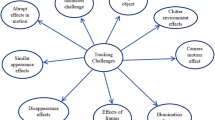Abstract
Tracking of moving objects in real situation is a challenging research issue, due to dynamic changes in objects or background appearance, illumination, shape and occlusions. In this paper, we deal with these difficulties by incorporating an adaptive feature weighting mechanism to the proposed growing competitive neural network for multiple objects tracking. The neural network takes advantage of the most relevant object features (information provided by the proposed adaptive feature weighting mechanism) in order to estimate the trajectories of the moving objects. The feature selection mechanism is based on a genetic algorithm, and the tracking algorithm is based on a growing competitive neural network where each unit is associated to each object in the scene. The proposed methods (object tracking and feature selection mechanism) are applied to detect the trajectories of moving vehicles in roads. Experimental results show the performance of the proposed system compared to the standard Kalman filter.







Similar content being viewed by others
Notes
Datasets of NGSIM are available at http://ngsim-community.org/
References
Alander J (1992) On optimal population size of genetic algorithms. In: Proceedings of computer systems and software engineering (CompEuro), pp 65–70
Amer A, Dubois E, Mitiche A (2003) Real-time system for high-level video representation: Application to video surveillance. In: Proceedings of the SPIE international symposium on electronic imaging, pp 530–541
Baker JE (1987) Reducing bias and inefficiency in the selection algorithm. In: Proceedings of the second international conference on genetic algorithms on genetic algorithms and their application, pp 14–21
Comaniciu D, Ramesh V (2000) Mean shift and optimal prediction for efficient object tracking. In: IEEE International conference of image processing, ICIP), pp 70–73
Comaniciu D, Ramesh V, Meer P (2000) Real-time tracking of non-rigid objects using mean shift. In: IEEE conference on computer vision and pattern recognition, pp 142–149
Culibrk D, Marques OF, Socek D, Kalva H, Furht B (2007) Neural network approach to background modeling for video object segmentation. IEEE Trans Neural Netw 18(6):1614–1627
Eshelman LJ (1991) The CHC adaptive search algorithm: How to have safe search when engaging in nontraditional genetic recombination. In: Foundations of genetic algorithms. Morgan Kaufmann, San Francisco, CA, pp 265–283
Gen M, Cheng R (1997) Genetic algorithm and engineering design, 1st edn. Wiley, New York
Grest D, Koch R (2004) Realtime multi-camera person tracking for immersive environments. In: IEEE 6th workshop on multimedia, signal processing, pp 387–390
Haritaoglu I, Harwood D, Davis L (2000) \(w^4\): real-time surveillance of people and their activities. IEEE Trans Pattern Anal Mach Intell 22(8):809–830
Jolliffe IT (2002) Principal component analysis, 2nd edn. Springer, New York
Leung F, Lam H, Ling S, Tam P (2003) Tuning of the structure and parameters of a neural network using an improved genetic algorithm. IEEE Trans Neural Netw 14(1):79–88
Liyuan L, Huang W, Gu I, Tian Q (2004) Statistical modeling of complex backgrounds for foreground object detection. IEEE Trans Image Process 13(11):1459–1472
López-Rubio E, Luque-Baena RM (2011) Stochastic approximation for background modelling. Comput Vision Image Understand 115(6):735–749
Lopez-Rubio E, Luque-Baena RM, Dominguez E (2011) Foreground detection in video sequences with probabilistic self-organizing maps. Int J Neural Syst 21(3):225–246
Luque RM, Domínguez EP, Muñoz J (2008) A neural network approach for video object segmentation in traffic surveillance. In: Springer (ed) Lecture notes in computer science, vol 5112. Springer, New York, pp 151–158
Luque R, Dominguez E, Palomo E, Muñoz J (2010) An art-type network approach for video object detection. In: European symposium on artificial neural networks, pp 423–428
Lv F, Kang J, Nevatia R, Cohen I, Medioni G (2004) Automatic tracking and labeling of human activities in a video sequence. In: Proceedings of the 6th IEEE international workshop on performance evaluation of tracking and surveillance
Nummiaro K, Koller-Meier E, Van Gool L (2003) An adaptive color-based particle filter. Image Vision Comput 21:99–110
Rautiainen M, Ojala T, Kauniskangas H (2001) Detecting perceptual color changes from sequential images for scene surveillance. IEICE Trans Inf Syst E84D(12):1676–1683
Raymer M, Punch W, Goodman E, Kuhn L, Jain A (2000) Dimensionality reduction using genetic algorithms. IEEE Trans Evol Comput 4(2):164–171
Siedlecki W, Sklansky J (1989) A note on genetic algorithms for large-scale feature selection. Pattern Recog Lett 10(5):335–347
Srinivas M, Patnaik L (1994) Adaptive probabilities of crossover and mutation in genetic algorithms. IEEE Trans Syst Man Cybernet 24(4):656–667
Srinivas M, Patnaik L (1994) Genetic algorithms: a survey. Computer 27(6):17–26. doi:10.1109/2.294849
Stauffer C, Grimson W (2000) Learning patterns of activity using real time tracking. IEEE Trans Pattern Anal Mach Intell 22(8):747–767
Welch G, Bishop G (1995) An introduction to the kalman filter. Tech rep, Chapel Hill, NC, USA
Yang J, Honavar V (1998) Feature subset selection using a genetic algorithm. Intell Syst Appli IEEE 13(2):44–49
Zhao T, Nevatia R (2004) Tracking multiple humans in complex situations. IEEE Trans Pattern Anal Mach Intell 26(9):1208–1221
Acknowledgments
This work is partially supported by the Ministry of Economy and Competitiveness of Spain under grant TIN2011-24141, project name Detection of anomalous activities in video sequences by self-organizing neural systems, and the Autonomous Government of Andalusia (Spain) under project P12-TIC-6213, project name Development of Self-Organizing Neural Networks for Information Technologies.
Author information
Authors and Affiliations
Corresponding author
Rights and permissions
About this article
Cite this article
Luque-Baena, R.M., Ortiz-de-Lazcano-Lobato, J.M., López-Rubio, E. et al. A Competitive Neural Network for Multiple Object Tracking in Video Sequence Analysis. Neural Process Lett 37, 47–67 (2013). https://doi.org/10.1007/s11063-012-9268-3
Published:
Issue Date:
DOI: https://doi.org/10.1007/s11063-012-9268-3




